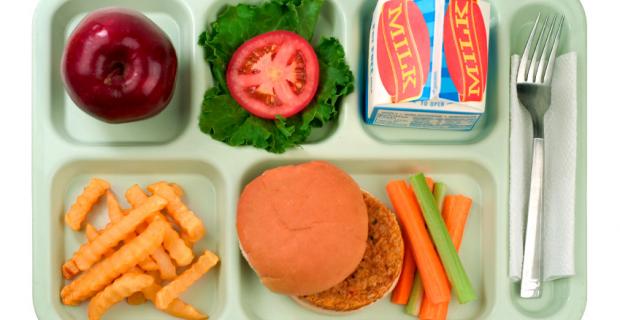What in Health Is Going on Here?

My mother was a junior high physical education teacher for many years, followed by a career as a health educator for the State Department of Maternal and Child Health in Kansas.
To this day, she has a sign on her bookshelf that reads, "What in health is going on here?"
Joan Dye Gussow, emeritus professor at Teachers College, Columbia University looks at the current obesity and nutrition-related health crisis and answers, simply, "We, the richest nation on Earth, are eating ourselves to death."
It’s not for lack of information that the crisis in children’s health is escalating. The volume of reports focusing on childhood obesity, rebuilding the food pyramid, and reinvigorating school physical education programs is sufficient to document the severity of the problem. Studies of the school meals systems in Italy and the U.K., the Government Accountability Office’s observations on the School Lunch Program, Slow Food USA’s Slow Food in Schools program, and the Center for Ecoliteracy's Rethinking School Lunch program provide us more than enough inspiration and ideas to transform the learning experience and the quality of meals served in our public schools. This broad-based consensus creates an unprecedented mandate for change.
Right now, we know what we need to do.
We need stronger connections between public education and public health. We need to recreate public schools as healthy learning environments, so that wherever students go — classrooms, gardens, kitchen classrooms, cafeterias, field trips, after-school activities, student clubs — and whatever activities they are engaged in, they receive a consistent message about health:
"Your school cares about your health and well-being. Your school practices what it teaches. All things are connected at school, just as they are in an ecosystem.
You, the students, are our message to the future, and we're sending you forward secure in your knowledge of how food reaches the table and the implications that has for your health and the future of the planet."
We know what we need to do.
Yet, as a society, we seem to lack the will to do it. Consistently, we fail to put this first thing first. Making the case for garden-based education and nourishing school meals in tight times is challenging, especially in a society that is annually subjected to $33 billion dollars of sophisticated messaging in favor of junk food, the lion's share of which is targeted at children. Imagine the public uproar if that amount of money were spent to promote teaching kids the wrong way to do math!
But sometimes in history a shift occurs. We may be seeing the beginnings of such a shift today. Some outstanding programs and opportunities scattered around the country are connecting garden-based learning to the lunchroom. A variety of schools, and sometimes districts, are bringing elements of this idea into action throughout the formal learning day. But for a shift of sufficient magnitude to occur and be sustained, individual programs need to be supported by systemic public policy and legislative solutions at the state and national levels.
Imagine what could happen if …
1. State legislatures and local authorities passed laws obligating school districts, cities, and counties to work together to include regional produce within public sector catering.
2. Voters decided via initiative to tax soda and candy, and directed the revenues to support the operational costs of serving more local produce at their schools, or decided to include in their next school district parcel tax funds to purchase and serve local produce, pay school gardeners, and staff kitchen classrooms.
3. The next statewide school facilities bond set aside funds for school gardens and for kitchens and equipment to replace heat-and-serve with meals prepared from fresh food.
4. Awards given to schools or requirements in the federal "No Child Left Behind Act" held schools accountable not only for students' scores on standardized tests, but also for the health of the school environment — measured by factors such as time devoted to garden-based learning, time allotted for lunch, the amount of junk food sold à la carte, off-campus time dedicated to experiential environmental education, and the health of the students themselves.
5. Every public school district board included garden-based learning in the wellness policies that they are required to adopt by the beginning of the 2006–2007 school year.
6. Food service workers were considered part of the educational team and received adequate training, education, and compensation to function as such.
7. The Integrated Waste Management Board or its equivalent worked with the state Service Employees Association to create school district salary schedules based on custodians becoming Certified Master Composters and operating school recycling and composting programs.
8. State requirements that cities and counties meet goals for reduction of wastes, as is now required in California, were expanded to include goals for school districts.
9. The state department of food and agriculture were mandated to advocate for school gardens and for school district procurement of home-state produce whenever possible; the legislature provided increased school food program reimbursements as a bonus for districts purchasing food grown in the state; and county agriculture commissioners set up databases of farmers willing to sell to schools.
10. County offices of education became partners with county agricultural commissioners, the Farm Bureau, Wildlife Federation, Sierra Club, Audubon Society, and others to open environmental camps in their own watersheds and create gardens in every school.
We know what we need to do.
Poet, farmer, and essayist Wendell Berry has written, "We need to change our present concept of education….The proper use of education is to enable citizens to live lives that are economically, politically, socially, and culturally responsible. A proper education enables young people to put their lives in order, which means knowing what things are more important than other things; it means putting first things first."
We know that garden-based learning, linked to meals at school and the academic curriculum, helps to put first things first. In such a program, the answer to "What in health is going on here?" is "Everything."




